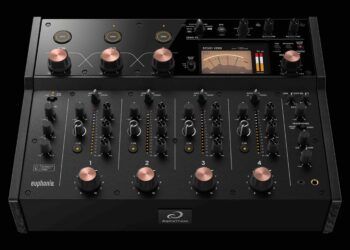ROLI – the company behind the original Seaboard, which came out over 14 years ago and then the Seaboard RISE more than 8 years ago – has returned with the Seaboard RISE 2. Today, we’re diving into our experience testing it out, and how it stands out in the space of MPE controllers.
What is the Seaboard RISE 2?
The RISE 2 is a versatile MIDI keyboard with options for any musician. You can plug in a sustain pedal, pair with other hardware instruments over the MIDI Port, or connect to more devices via USB-C. Its major difference compared to conventional MIDI keyboards is its infinitely expressive keyboard. This allows for more expressive playing, whilst using MPE presets (Midi Polyphonic Expression – a more expressive way to play with your software instruments. We’ll refer to it as MPE here). With one finger, you can slide around the top or the bottom of the Seaboard RISE 2 to create flawless buildups or transitions in your songs – expression that just wasn’t possible before in conventional MIDI Keyboards.
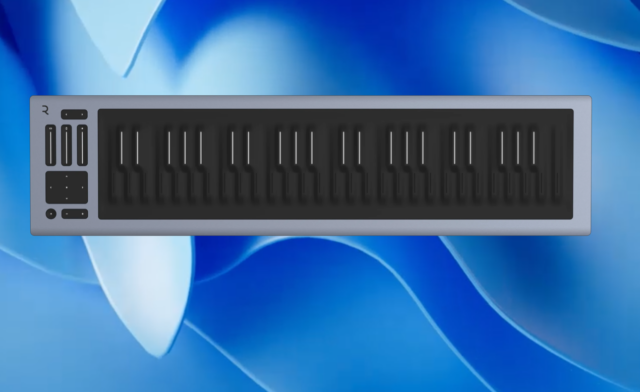
A step up from its predecessor: the RISE 2 vs. RISE 1 and other MPE controllers
As well as a slight change in the size and shape of the keys compared to the original RISE 1, the RISE 2 now includes “precision frets”. These are small ridges that have been added to the Seaboard’s surface to enable more accurate playing. The frets are wider and more articulated than the RISE 1, which makes the RISE 2 easier to play. Your fingers can find the keys more easily, offering a more traditional keyboard approach – all the while keeping the gear’s uniqueness and MPE functionality. In layman’s terms, this means that if you’re more of a traditional keys player, the RISE 2 should be easier to adapt to and play with than the RISE 1.
That said, it should still be approached as a completely new instrument because the RISE 2 provides you with a better level of control not found on a traditional MIDI Keyboard. The concept of expressiveness is not just a catchphrase here. When playing with it, I instantly felt compelled to slide my finger around the frets and give different levels of pressure to engage with its MPE-capable presets. This tactile sensation is a must-experience in order to truly understand why the RISE 2 feels so prominently like a new instrument in its own right.
I should mention that I am quite familiar at this point with MPE, which the Seaboard RISE 2 is built around. Having owned several different MPE controllers over the last few years, I can say that the RISE 2 doesn’t disappoint in its build quality either. It’s a well-constructed controller, and everything feels played out nicely.
Unlike my other MPE controllers, though, I did find that the RISE 2 has a steep learning curve. If you’ve never played a Seaboard RISE keyboard before then it will take some getting used to, in terms of finding the notes and getting it to play musically. However, when I stopped trying to use it as a more traditional MIDI controller, I found an advantage – you can experiment in ways unimaginable with a traditional MIDI controller.
This led me to find new, more expressive ways to create sounds and interact with my work-in-progress productions. For example, I could apply strings over a techno track I’m working on, then easily manipulate them to sound as realistic as using an actual instrument would sound. Based on my experience, I’d argue that this level of duplication ability is truly not possible with a traditional MIDI controller (though I’d love to know if you’ve found otherwise in your MIDI experimentation).
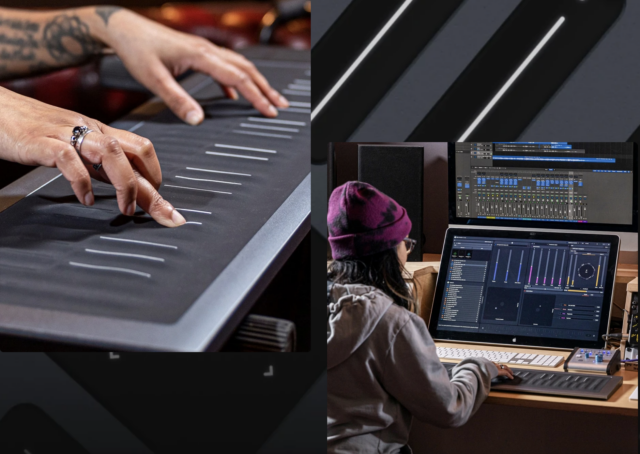
A versatile & expressive keyboard
A New Way to Play with the RISE
Let’s go into more detail about my time playing with this instrument.
Using its soft, black silicon “keywave” surface – its own take on a keyboard
The ROLI Seaboard RISE 2 represents a departure from conventional keyboard instruments. Its unique and intuitive design transforms the playing experience by combining the familiarity of a keyboard with the expressiveness of a string instrument. The key innovation lies in the “keywave” surface, which allows for continuous touch sensitivity along the length of each key. This means that musicians can shape their sound in real-time by applying pressure, sliding their fingers, or even vibrato-like movements, resulting in an unprecedented level of musical expression.
Five dimensions of touch
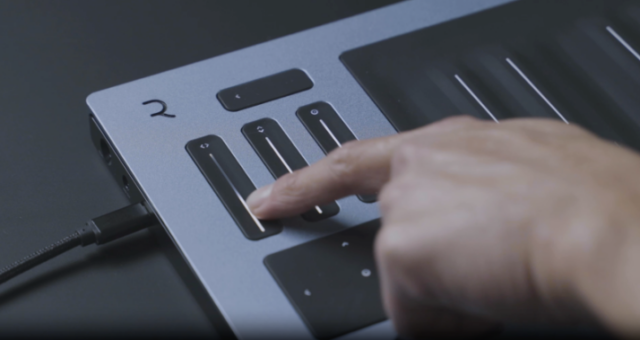
Unlike traditional keyboards, the Seaboard RISE 2 introduces five dimensions of touch: strike, press, glide, slide, and lift. Each touch dimension provides a distinct way to manipulate sound, enabling musicians to create subtle nuances and dynamic variations.
From gentle and delicate melodies to powerful and expressive performances, the RISE 2 offers a wide range of previously unimaginable possibilities. For me, this is where the Seaboard RISE 2 outshines my other MPE controllers, such as the Lumi Keys (also by ROLI) & the Sensel Morph. It offers the next level of expressiveness which is only found on a keyboard controller of this kind.
One of my favorite attributes is being able to slide my finger across to the top of the key bed to create subtle build-ups or even a Theremin-style effect to my tracks! It’s really cool, especially for those who want to create unique sound effects or sound design.
MPE compatibility
The Seaboard RISE 2 is compatible with MPE, a new standard that allows individual control of multiple parameters for each note played. If you’re not familiar, MPE – a true breakthrough in MIDI technology – further enhances the Seaboard’s capabilities, enabling musicians to control pitch, modulation, and other parameters independently for every note. This allows for a whole new world of sonic exploration, making the Seaboard RISE 2 an essential tool for musicians, producers, and sound designers seeking to push their creative boundaries.
If you want to make something sound real, the Seaboard RISE 2 will do that with ease. For example, check out this dream-like guitar preset played with the Seaboard RISE 2 utilizing MPE here:
Using RISE 2 with Equator 2, ROLI’s software synthesizer
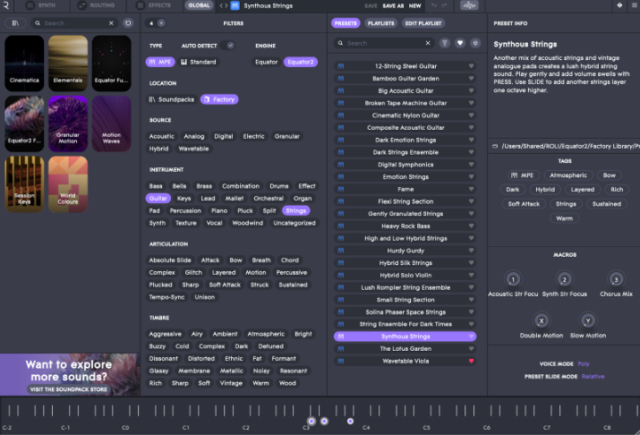
To complement its exceptional hardware, the Seaboard RISE 2 comes bundled with a wide range of software and sound libraries. The Equator 2, ROLI’s flagship software synthesizer, provides a rich palette of sounds specifically designed to take advantage of the Seaboard’s expressive capabilities.
Additionally, the RISE 2 also integrates with other popular DAWs and virtual instruments such as SWAM which features a bunch of virtual instruments like Clarinets, Saxophones, Violins, etc, which can easily be manipulated by the RISE 2.
You can get a deeper dive into the Equator 2 software that drives the RISE with me here:
The RISE 2: inspiring musicians and the future of music across the board
The Seaboard RISE 2 has already garnered a dedicated following among musicians, composers, and producers. Renowned artists such as Hans Zimmer, Stevie Wonder, and Jordan Rudess have embraced the instrument, harnessing its unique features to craft captivating and emotive performances. With its ability to break free from traditional musical constraints, the Seaboard RISE 2 paves the way for new genres, sonic landscapes, and experimental approaches to music production.
For example, Jason Turk – a traditional Irish musician – has embraced the RISE 2 in his compositions and performances. His work really shows how versatile this instrument can be.
My love-hate relationship with the RISE 2: Pros and Cons
I love that the RISE 2 offers such an expressive and versatile playing experience. I appreciate its portability and durability as well. Plus, with MIDI Polyphonic Expression (MPE) compatibility and customization options for settings and mappings, there’s much to love about it.
However, it comes at a premium cost of $1,189 USD and the learning curve for newer users is not to be ignored either. It is dependent on external software sound, has limited connectivity, and is a niche instrument that is only limited to experimental or expressive music. That said, when considering whether it’s worth it, it ultimately comes down to your purpose with purchasing it. However, if that niche instrument is right up your alley, you will be rewarded with a high-quality instrument that will allow you to do exactly what you want: make software instruments sound real.
ROLI’s Seaboard RISE 2: the last word on this innovative instrument
Depending on what you want to achieve in the world of music creation, there is no doubt that the Seaboard RISE 2 is an innovative piece of gear. If you’re the type that has to capture your expressive playing while recording, it’s worth a look – especially if you want to explore its sound design capabilities.
It’s not for everyone, but for those who it is, it opens the door to a new way to capture your expressive performances which wasn’t possible before with a standard MIDI keyboard. I’ve thoroughly enjoyed my time creating new sonic possibilities with it and incorporating it into existing song ideas. There isn’t anything else in my arsenal of MIDI keyboards which is quite like the RISE 2. It stands out uniquely and excitingly and as you may have gathered already from my article, I do enjoy the inspiration it brings to existing and new musical ideas. If you’re stuck in a musical rut, the RISE 2 may get you out.
ROLI Seaboard RISE 2 is currently available for USD $1189 (regular price USD $1399) at the time of publishing this article. It is shippable to customers in the US, Canada, UK, and Europe.
– Emlyn Lucas, Emlyn in the Mix, on YouTube


![ROLI’s Seaboard RISE 2: seamless integration into the expressive world of MPE [REVIEW]](https://s11234.pcdn.co/wp-content/uploads/2023/11/Screenshot-2023-11-16-at-5.02.41-pm.png)


